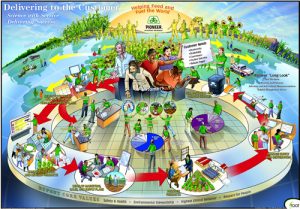
Customer journey mapping has become very popular. Emerging CX programs are viewing it as a great way to start learning about their customers and the resulting visual aid is an easy way to share customer information around the organization. Because of its popularity, however, I’m starting to see less-than-successful approaches to the practice. Here are what I see as the five biggest mistakes.
1. Starting a Customer Journey Map without an End Goal
Since customer journey mapping has become in vogue, it has become “the deliverable” and not a means to an end. In fact, I’ve had clients come to me requesting a journey map as their #1 goal. When I ask them what they’re trying to accomplish, they say, “I want to create a journey map.” Not, “I want to improve customer retention,” or “I want to increase customer satisfaction.” The journey map has become an end unto itself.
If you don’t have a business reason for creating a journey map, stop before you begin. Too many organizations have a journey map on their wall that took time to create yet produced zero benefit for the company. By starting with a goal in mind, it’s much easier to decide which journey(s) you’d like to explore and what attributes you’re trying to improve. For instance, if you’re trying to improve new business acquisition, you may use your journey map to determine where your potential customers get stuck when trying to buy from you. If you started the map with no goal, you might not focus on those sticking points.

2. Process Mapping Instead of Customer Journey Mapping
My friend and fellow CX professional worked with a client that said, “I’ve journey mapped all 26 points of the customer’s journey – now what?” My friend’s immediate reply, “How many of those points is the customer actually aware of?” The answer: “Uh, I don’t know.”
Through the success of 6 Sigma process improvement and its predecessor, Total Quality Management, we’ve all become good at process mapping. We can trace the workflow from its origins all the way through the end of the process. Unfortunately, we sometimes use those skills to map all the internal steps of a customer interaction and not the customer-facing ones. We can’t forget the “customer” in “Customer” Journey Mapping. By looking at the journey from the customer’s point of view, we not only clearly see the good & bad of our interactions with the customer, we also gain insight into the thoughts, attitudes and emotions of our customers. And it is with those insights that we begin to truly understand how to improve their journey.

3. Getting Your Employees’ Perspectives, But Not the Customers’
Despite the whining you sometimes hear from employees, it’s fairly easy to get them to participate in a journey mapping workshop. In less than 8 hours, you can create a journey map that has the basics of your customers’ experience. The benefits of starting with employees include:
A. Creating buy-in for the map because the employees participated in its creation
B. Building camaraderie amongst employees
C. Improving internal processes – when employees talk about how they do their job, there are often learnings about how they affect their downstream internal customer
But, don’t stop there! Employees only have a partial view of the customer journey. They aren’t familiar with what the customer does before they interact with your brand (and 57% of the sale is complete before a customer even talks to your sales representatives) not to mention the part of their journey that occurs before the customer talks with an employee. In addition, employees aren’t inside their customers’ hearts and minds. They don’t feel the same emotions, frustrations and elation the customer feels. Without that, your customer journey map is incomplete. Both qualitative (either online or in person) and quantitative research are excellent ways to get your customers’ perspectives. I recommend doing both as they provide different information and one can feed the other.
4. Only Looking at the Existing Customer Journey – Not What Could Be
This is the most common mistake I see in customer journey mapping. Even if you start with a goal and truly journey map with input from your customer, most organizations stop when they have an accurate depiction of the existing journey. That’s not bad, but again, it’s incomplete.
For example, when mapping a customer’s journey to obtain a mortgage, a national lender accurately mapped all their interactions with the customer. They understood that the loan application process was the most important part of retaining a client, but couldn’t pinpoint why some customers went elsewhere for their next mortgage. The reason their perception was incomplete was because they didn’t look at the “white space” on their journey map.

Upon further investigation, they found that some customers were very uneasy about whether or not their loan would be approved. They submitted their application and required paperwork and then waited for weeks to hear back from the lender. That negative experience stuck with them until it was time to get their next loan. Even if they couldn’t put their finger on it, they just had a bad feeling about the lender and sought out a competitor. Armed with this knowledge, the lender added steps to the journey where they interacted with their customers more during the application & underwriting process. The result: hundreds of millions worth of additional loans in their portfolio.
5. Not Systematically Prioritizing Your Improvement Efforts
How do you choose which improvement projects to kick off when your customer journey map is complete? Is it the area where your manager has a special interest? Is it the solution that seems the easiest? How about just going with the opinion of the person who has the loudest voice in the room? Unfortunately, I’ve seen all of these … and they’re all bad.
The approach where I’ve seen the most success is a statistical evaluation of which of your potential improvements provides you the largest movement on your business goal (see #1 above). In other words, where’s your biggest bang for your buck? By statistically tying satisfaction or loyalty scores at given journey points with a customer’s response to your overall metric (e.g. how likely you are to stay a customer for life) you can determine where to focus your improvement efforts. Few things are more frustrating than kicking off 20 projects to address deficiencies when only a few will really move the needle. By leveraging statistics, you can take the emotion and gamesmanship out of deciding which projects are worthy of your attention and you’re much more likely to get the results you want.

Customer journey mapping is and will remain a staple for CX leaders everywhere. The key is to create the map in such a way that it produces the results you want.
Full disclosure: I’m the VP of Client Solutions at Pacific Consulting Group and we provide enhanced journey mapping that addresses all these points and more. I’d be happy to help you with your journey mapping project, but if you’d like to do it yourself, that’s cool too. In the end, we’re all customers and I want our experiences to be awesome – regardless of who made them that way.
Photo Credits:
Headline photo: http://watercoolernewsletter.com/cultivating-the-strategy-through-our-employees/
Twisted arms: http://www.illustrationsource.com
Process map: http://moveableonline.com/blog/2016/11/06/beginners-guide-process-mapping/
Anxious customer: https://www.jeremysaid.com/blog/conversion-triangle-series-reducing-anxiety/?hvid=1toQ4x
Boss shouting: http://www.businessinsider.com/6-ways-to-respond-to-your-boss-yelling-at-you-2015-8



![[Research Round-Up] New Study Shows the Continuing Value of B2B Thought Leadership](https://customerthink.com/wp-content/uploads/development-2010010_1280-pixabay-innovation-ideas-think-1-218x150.jpg)